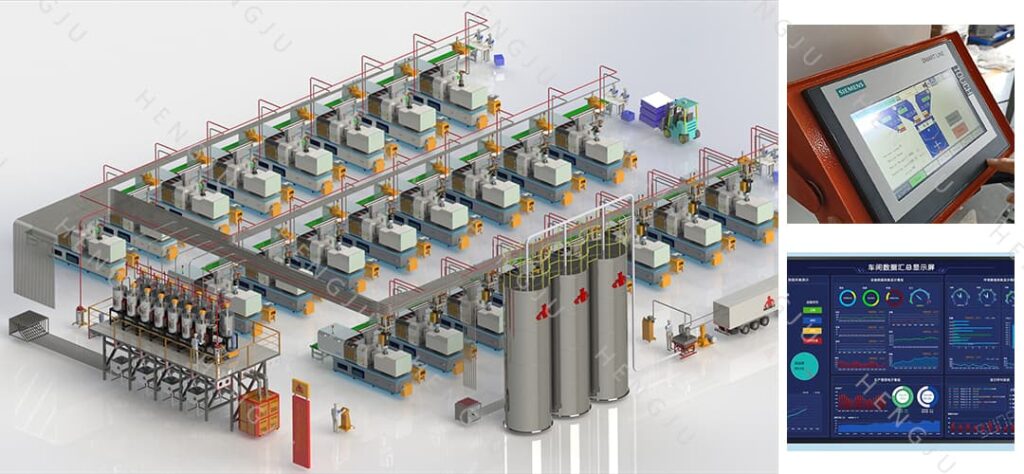With the continuous development of modern manufacturing industry, injection molding technology plays an increasingly important role in the processing technology of plastic products. The introduction of automobile development strategies in the new century, such as automobile lightweight, energy saving and emission reduction, has made plastic products widely used in the automobile industry.
From the engine intake manifold, the hood to the housing of the air filter and more. There are plastic products almost everywhere around the car engine, and injection molding, which is the first processing procedure of plastic products, is also facing new challenges. The central conveying system has been widely used in modern injection molding workshops.
The central feeding system can automatically supply a variety of raw materials to any injection molding processing equipment through the drying treatment of raw materials, color matching treatment, and proportional crushing and waste recycling, and can achieve a high degree of automatic control and monitoring, as well as meet 24 hours. The production needs of intermittent feeding. However, with the continuous increase of production volume and the limitation of the drying capacity of the dryer, the drying time and delivery volume of plastic particles cannot be controlled in relation to each other, which cannot meet the production needs.

Through the improvement of the functional modules of the control system of the central conveying system, the actual verification of the correlation control between the drying time and the conveying volume of plastic particles was carried out. The following is the main content.
1. The structure of centralized feeding system
The centralized feeding system of the injection molding machine is a process in which the raw materials are centrally processed (mixed and dried), and then powered by a Roots-type fan, and delivered to the injection molding machine through a dedicated delivery pipeline.
Due to the different manufacturing processes of the products, the configuration and composition of the centralized feeding system are also different. However, it generally includes the following parts: raw material storage, mixing, drying equipment; raw material delivery equipment;
2. Dryer feeding capacity
According to different raw materials, dryers can be divided into hot air dryers, dehumidifier dryers and vacuum dryers. The feed capacity of each dryer is different and depends on the drying time T of the plastic pellets and the volume V of the barrel.
3. Product forming ability
The injection molding machine mainly uses the thrust of the screw (or plunger) to inject the plasticized plastic in the molten state (ie, viscous fluid state) into the closed mold cavity, and obtain the corresponding plastic products after curing and shaping. Its product molding capacity, that is, the number of plastic particles required by the injection molding machine per hour, is determined by the average weight of the product and the molding time of a single product.
4. Dryer feeding schedule
There are generally two types of plastic particles used in factories, PP (polypropylene) and PA (polyamide). According to the difference of baking material temperature and baking time, it can also be subdivided into hundreds to thousands of types. In the actual production process, a dryer is often versatile and can dry many kinds of plastic particles.
Therefore, the number of dryers in the factory is often less than the number of injection molding machines, which makes multiple injection molding machines need a dryer to feed through the centralized feeding system at the same time. In addition, due to the special requirements of some plastic particles, as well as cost and energy saving considerations, these plastic particles can only be dried on a fixed dryer. In the actual production process, only a single dryer can feed the injection molding machine.
5. System defects
When multiple injection molding machines need a certain dryer to feed at the same time, the number of injection molding machines may be greater than the maximum value of N, which will lead to insufficient feeding capacity of the centralized feeding system of the dryer. Part of the plastic particles are transported to the injection molding machine for production before the specified drying time is reached.
In this way, defects such as pores and trachoma will appear in the produced plastic products, and the product quality cannot meet the processing requirements, and the service life of the injection molding machine will be shortened.


